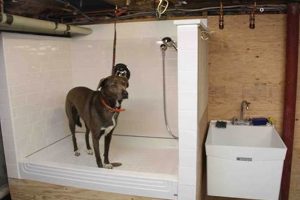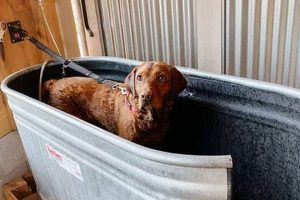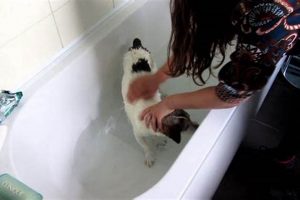The crafting of canine neckwear from durable nylon rope, often undertaken as a do-it-yourself project, provides a personalized and robust alternative to commercially manufactured options. For instance, an individual might choose to braid several strands of brightly colored cord into a custom design to suit their pet’s size and personality.
Creating such items offers several advantages, including cost-effectiveness and the opportunity for customization. The robust nature of the material ensures longevity and reliability, potentially exceeding that of standard collars. Historically, the practice of braiding rope for functional purposes predates modern manufacturing processes, reflecting a reliance on readily available resources and handcrafting skills. This activity extends beyond mere utility; it fosters a deeper connection between owner and animal through the creation of a unique and functional object.
Subsequent sections will detail the necessary materials and equipment, provide step-by-step instructions for several braiding techniques, and offer guidance on ensuring a secure and comfortable fit for the animal. This guidance will emphasize both safety and aesthetic considerations.
Tips for Paracord Canine Neckwear Construction
Constructing a secure and aesthetically pleasing restraint for canines from braided nylon cord requires careful attention to detail and adherence to best practices.
Tip 1: Accurate Measurement is Paramount. Precise measurement of the canine’s neck circumference is crucial for a comfortable and secure fit. Add at least two inches to the measured circumference to ensure adequate adjustability and prevent constriction.
Tip 2: Employ High-Quality Paracord. Utilize only authentic, commercially produced paracord, rated to withstand significant tensile force. Avoid imitation or “craft” cord, as its strength and durability may be compromised.
Tip 3: Secure Weaving Techniques are Essential. Employ established paracord braiding techniques, such as the cobra weave or king cobra weave, to maximize strength and prevent unraveling. Ensure knots are meticulously tightened and secured.
Tip 4: Utilize Appropriate Hardware. Select durable, rust-resistant hardware, such as stainless steel D-rings and side-release buckles, specifically designed for canine applications. Ensure the hardware’s load rating exceeds the canine’s weight and pulling force.
Tip 5: Prioritize Safety Considerations. Regularly inspect the finished restraint for signs of wear or damage, including frayed cords or weakened hardware. Replace the restraint immediately if any compromise to its structural integrity is detected.
Tip 6: Consider adding a loop for ID tags. Leave a dedicated loop when weaving the cord. This provides a secure place to attach ID tags or even a small light.
Tip 7: Melt and Fuse Cord Ends. Following completion of the braiding, carefully melt and fuse the ends of the paracord to prevent fraying. Exercise caution when using heat to avoid burns and ensure adequate ventilation.
Tip 8: Check For Fit. Regularly verify that two fingers can fit comfortably between the finished item and the canines neck. This confirms that the item is neither too tight nor too loose.
Adherence to these recommendations enhances the safety, durability, and aesthetic appeal of the constructed items, providing a reliable and personalized solution for canine restraint.
The subsequent section will provide guidance on more advanced construction techniques, including incorporating reflective elements and custom color patterns.
1. Durability
Durability, in the context of canine neck restraints constructed from braided nylon cord, constitutes a paramount consideration. The operational lifespan and dependability of such an item are directly correlated with the inherent strength and resilience of its constituent materials and construction.
- Tensile Strength of Paracord
Authentic 550 paracord, commonly employed in these projects, possesses a minimum tensile strength of 550 pounds. This rating signifies the cord’s capacity to withstand substantial pulling forces without fracturing, a crucial attribute given the propensity of canines to pull on leashes or become entangled in obstacles. Inferior or imitation cord may exhibit significantly lower tensile strength, compromising the overall integrity of the finished product.
- Abrasion Resistance
The exterior sheath of paracord is engineered to resist abrasion from contact with various surfaces, including concrete, vegetation, and metal. This abrasion resistance mitigates wear and tear that would otherwise degrade the structural integrity of the restraint over time. Regular exposure to abrasive environments necessitates periodic inspection for signs of fraying or thinning of the cord.
- Knot Security and Load Distribution
Properly executed and secured knots are essential for distributing load evenly throughout the braided structure. Improper knotting techniques can create stress points that weaken the overall construction and increase the likelihood of failure. Employing established paracord knotting methods and meticulously tightening each knot contribute significantly to the restraint’s load-bearing capacity.
- Hardware Integration
The durability of integrated hardware, such as D-rings and buckles, is equally critical. Stainless steel or corrosion-resistant alloys are preferred materials, as they resist degradation from exposure to moisture and environmental contaminants. The hardware’s load rating must also be commensurate with the canine’s size and strength to prevent breakage or deformation under stress.
The interplay of these facets collectively determines the overall longevity and dependability of a handmade canine neck restraint. Careful material selection, meticulous construction, and diligent maintenance are essential for maximizing its operational lifespan and ensuring the safety and security of the animal.
2. Customization
The opportunity for customization is a central tenet of creating canine neckwear from braided nylon cord. This aspect allows for a tailoring of the item to specific needs, preferences, and even the individual characteristics of the animal.
- Color Palette Selection
The extensive availability of nylon cord in a wide spectrum of colors allows for personalized aesthetic choices. Owners can select colors that complement the canine’s coat, reflect personal preferences, or even incorporate high-visibility hues for enhanced safety during low-light conditions. Examples include using camouflage patterns for hunting dogs or bright neon colors for increased visibility in urban environments. The implications extend beyond mere aesthetics, potentially impacting the canine’s visibility and safety.
- Braiding Pattern Variation
Numerous braiding techniques exist, each offering unique structural and visual characteristics. From the simple cobra weave to more complex patterns like the king cobra or Solomon bar, the choice of braiding pattern influences the item’s thickness, texture, and overall aesthetic appeal. Furthermore, certain braiding patterns can enhance the item’s strength or incorporate specific functional elements, such as integrated handles or attachment points.
- Size and Adjustability Calibration
Unlike mass-produced items, DIY construction allows for precise calibration of size to ensure a comfortable and secure fit. Adjustability can be incorporated through the use of sliding knots or adjustable buckles, accommodating variations in neck circumference or seasonal fluctuations in fur density. This precise sizing minimizes the risk of chafing or slippage, contributing to the canine’s comfort and safety.
- Hardware Integration Preferences
The selection of hardware components, such as D-rings, buckles, and closures, offers further customization opportunities. Owners can choose hardware based on material (e.g., stainless steel, brass), size, and style, ensuring compatibility with leashes and other accessories. The choice of side-release buckles over traditional buckles, for instance, can enhance ease of use and facilitate quick removal in emergency situations.
These customizable facets underscore the inherent advantages of constructing canine neckwear from braided nylon cord. The ability to tailor color, braiding pattern, size, and hardware allows for the creation of items that are not only functional and durable but also reflect the unique bond between owner and animal.
3. Security
The security afforded by a canine neck restraint constructed from braided nylon cord is a primary determinant of its suitability. A poorly designed or constructed item presents a risk of escape, potentially endangering the animal and other parties. The connection between security and these handcrafted items stems from the material strength, weaving technique, and hardware integration, each contributing to the overall integrity and reliability of the restraint.
Material selection is a crucial initial step. Authentic 550 paracord, with its specified minimum tensile strength, provides a robust foundation. Weaving techniques, such as the cobra weave or king cobra weave, enhance security by distributing force across multiple strands, minimizing the risk of single-point failure. Hardware, including D-rings and buckles, must also possess adequate strength and corrosion resistance to withstand environmental stressors and the canine’s pulling force. For example, a small dog collar might successfully use lighter duty hardware, whereas a larger, more powerful dog would require heavy-duty, reinforced components to ensure that buckles do not break or rings become distorted under duress. Inadequate materials can lead to the restraint breaking during regular activity, defeating the purpose of restraint altogether. Equally important is the secure knotting. A loosely or improperly tied knot could come undone with the pulling, jerking, and general wear of the canine.
Ensuring security in a handmade canine neck restraint involves a comprehensive assessment of materials, construction techniques, and anticipated usage conditions. The combination of high-quality materials, secure weaving, and durable hardware contributes significantly to the animal’s safety and prevents unintended escapes. Failure to address these elements compromises the intended function of the device and poses potential safety risks to the animal and its surroundings.
4. Comfort
Comfort, regarding canine neckwear constructed from braided nylon cord, warrants careful consideration to prevent skin irritation, chafing, or restriction of movement, thus ensuring the animal’s well-being.
- Material Selection and Tactile Properties
The choice of nylon cord directly influences the tactile experience for the canine. While durable, nylon can be abrasive against sensitive skin, particularly if the weave is tight or the cord is stiff. Selecting a softer, more pliable paracord, or incorporating a fabric lining, mitigates potential irritation. The inherent properties of the material, therefore, require careful evaluation to prioritize the animal’s comfort.
- Proper Sizing and Fit Calibration
An ill-fitting neck restraint, whether too tight or too loose, can cause discomfort and potential injury. A restraint that is too tight restricts breathing and blood circulation, while one that is too loose presents a risk of entanglement or escape. Precise measurement of the canine’s neck circumference and the incorporation of adjustable features are crucial for achieving a comfortable and secure fit. Regular monitoring of the fit is also necessary, particularly for growing animals or those with fluctuating weight.
- Weave Density and Flexibility
The density and flexibility of the braided pattern affect the conformity of the restraint to the canine’s neck. A tightly woven, rigid structure may create pressure points or restrict natural head movement. Conversely, a looser weave may lack structural integrity and contribute to slippage. Balancing weave density with flexibility is essential for maximizing comfort without compromising security. Experimentation with different braiding patterns may be necessary to achieve an optimal balance.
- Hardware Placement and Padding
The placement and design of hardware components, such as buckles and D-rings, can impact comfort. Hardware positioned directly against the skin can cause irritation or pressure sores. Padding these components with soft fabric or strategically positioning them away from sensitive areas minimizes these risks. Furthermore, the weight and profile of the hardware should be considered, as bulky or heavy components can contribute to discomfort, particularly for smaller canines.
The multifaceted nature of comfort in canine neck restraints necessitates a holistic approach, considering material properties, fit, weave characteristics, and hardware integration. Prioritizing these factors during construction ensures not only the security and functionality of the item but also the animal’s sustained well-being. The creation of a comfortable restraint demonstrates responsible pet ownership and strengthens the bond between animal and owner.
5. Aesthetics
The aesthetic dimension of canine neckwear crafted from braided nylon cord represents a significant consideration for many owners. Beyond mere functionality, the visual appeal of such items allows for a personalized expression of style and a reflection of the bond between owner and animal. The importance of aesthetics stems from the desire to create an item that is not only practical but also visually pleasing, aligning with the owner’s individual tastes and the dog’s unique characteristics. For instance, an owner might choose a vibrant color palette to complement their dog’s energetic personality or opt for a more subdued, classic design for a more refined look. The choice directly affects the perceived image of the animal and, by extension, its owner.
The cause-and-effect relationship between design choices and aesthetic impact is readily apparent in several aspects of construction. Color selection, braiding pattern, and hardware finish all contribute to the overall visual impression. A carefully chosen color combination can enhance the dog’s natural features, while a well-executed braiding pattern can add texture and visual interest. The integration of polished metal hardware can elevate the item’s perceived quality and sophistication. The practical application of this understanding lies in the ability to create a neck restraint that serves its functional purpose while also enhancing the dog’s appearance and reflecting the owner’s personal style.
In summary, the aesthetic aspects of constructing canine neckwear from braided nylon cord extend beyond superficial considerations. They represent a tangible expression of the owner-animal bond and allow for a personalized statement of style. While durability, security, and comfort remain paramount, the conscious integration of aesthetic elements contributes significantly to the overall satisfaction and perceived value of the finished product. The challenge lies in balancing aesthetic preferences with functional requirements, ensuring that the visual appeal does not compromise the item’s primary purpose: to provide a safe and reliable means of restraint. This element links directly to a broader theme of human-animal interaction and the ongoing effort to integrate functionality with personal expression in pet ownership.
6. Functionality
The utility of canine neckwear constructed from braided nylon cord, often a do-it-yourself endeavor, is paramount. The primary purpose of such an item is to provide a secure and reliable means of restraint and control, facilitating safe walks and preventing escapes. Functionality extends beyond basic containment, encompassing features that enhance the user experience and contribute to the animal’s well-being.
- Leash Attachment Integrity
A critical functional aspect is the secure attachment point for a leash. The D-ring or similar hardware must be robustly integrated into the braided structure, capable of withstanding significant pulling forces without deformation or detachment. For instance, a poorly secured D-ring could separate during a walk, resulting in the loss of control of the animal. The implications of this failure range from minor inconvenience to serious safety hazards, particularly in high-traffic areas. The choice of attachment method and the quality of materials directly influence the item’s reliability in this critical function.
- Identification Tag Accommodation
The ability to securely attach identification tags is another essential functional consideration. In the event of escape, clearly legible identification can expedite the animal’s return to its owner. Integrated loops or dedicated attachment points for tags should be designed to prevent loss or damage to the tags themselves. An example of effective design would be a small, durable loop woven directly into the braid, sized to accommodate standard ID tags without excessive movement or wear. Failure to provide adequate tag accommodation compromises the effectiveness of this crucial safety measure.
- Adjustability and Ease of Use
A functional item must be easily adjustable to accommodate variations in neck circumference or seasonal changes in fur density. Adjustable buckles or sliding knots allow for a customized fit that prevents chafing or constriction while maintaining a secure hold. Ease of use extends to the attachment and removal of the item, particularly in emergency situations. A complex or cumbersome closure mechanism can hinder quick removal, potentially delaying necessary medical intervention or rescue efforts. The design should prioritize simple, intuitive operation without compromising security.
- Durability and Resistance to Environmental Factors
A functional canine neck restraint must withstand exposure to various environmental conditions, including moisture, sunlight, and abrasion. The materials and construction techniques should minimize degradation from these factors, ensuring the item’s longevity and continued reliability. For example, a restraint constructed from non-UV resistant materials may become brittle and prone to failure after prolonged sun exposure. Similarly, a restraint that absorbs moisture may become heavy and uncomfortable for the animal. Selection of weather-resistant materials and robust construction methods are essential for maintaining functionality over time.
These functional facets are inextricably linked to the overall value and effectiveness of canine neckwear crafted from braided nylon cord. While aesthetics and customization offer personalized appeal, the primary function of such items remains the safe and reliable restraint of the animal. A well-designed and constructed restraint prioritizes these functional considerations, ensuring both the animal’s well-being and the owner’s peace of mind.
7. Affordability
The economic advantage inherent in constructing canine neckwear from braided nylon cord represents a significant factor for many pet owners. The accessibility of materials and the elimination of retail markups contribute to the overall cost-effectiveness of this do-it-yourself approach. This element underscores the importance of resourcefulness and practical skill in mitigating the expenses associated with pet ownership.
- Raw Material Acquisition Costs
The primary expenditure in creating a canine neck restraint from braided nylon cord lies in the acquisition of raw materials: paracord, buckles, and D-rings. These materials are generally available at craft stores, online retailers, and surplus outlets, often at prices significantly lower than those of pre-made commercial products. The choice of purchasing in bulk or utilizing salvaged materials can further reduce the cost, enhancing the overall affordability of the project. The financial implications involve the potential for substantial savings compared to purchasing ready-made collars, especially for owners with multiple pets or specific design preferences.
- Labor Input vs. Monetary Investment
The time and effort invested in constructing a canine neck restraint represents a trade-off against monetary expenditure. While the materials themselves are relatively inexpensive, the braiding process requires manual dexterity and a time commitment. However, this labor input translates directly into cost savings, as the owner is essentially substituting their own time for the labor costs embedded in commercially produced items. The implications include the opportunity to learn a new skill, engage in a rewarding creative process, and exercise greater control over the quality and design of the finished product, all while reducing overall expenses.
- Longevity and Replacement Frequency
The durability of a well-constructed canine neck restraint from braided nylon cord contributes to its long-term affordability. The robust nature of the materials ensures resistance to wear and tear, reducing the need for frequent replacement. This is in contrast to some commercially produced collars that may utilize less durable materials or construction methods, necessitating more frequent purchases. The impact includes reduced long-term expenses and a decreased environmental footprint due to less frequent disposal of worn-out items.
- Customization and Reduced Waste
The ability to customize the design and size of a canine neck restraint allows for efficient use of materials and minimizes waste. Unlike purchasing pre-made collars in standard sizes, the do-it-yourself approach enables the creation of items tailored precisely to the animal’s measurements, reducing the likelihood of unused excess material. The environmental and economic implications of this customization are significant, promoting resource conservation and minimizing the cost associated with purchasing unnecessarily large or ill-fitting items.
The aggregation of these factors underscores the significant affordability advantage associated with constructing canine neckwear from braided nylon cord. The relatively low cost of materials, the opportunity to substitute labor for monetary expenditure, the enhanced durability, and the potential for customization all contribute to a cost-effective alternative to purchasing commercially produced items. This approach resonates particularly strongly with budget-conscious pet owners and those seeking greater control over the quality and sustainability of their pet-related purchases.
Frequently Asked Questions
The following addresses common inquiries regarding the creation and use of canine neckwear constructed from braided nylon cord.
Question 1: What is the expected lifespan of a paracord dog collar?
The lifespan varies based on usage intensity, environmental exposure, and construction quality. Properly constructed collars, utilizing genuine 550 paracord and quality hardware, can withstand several years of regular use. Frequent inspection for wear and tear is essential.
Question 2: Is paracord safe for use around a dog’s neck?
Yes, provided the collar is correctly sized and fitted. The two-finger rule (ensuring two fingers can comfortably fit between the collar and the dog’s neck) should be adhered to, preventing constriction. Regular inspection is critical to preventing injury.
Question 3: Can a paracord dog collar be used for tie-out purposes?
It is generally not recommended to use a paracord dog collar solely for tie-out purposes, particularly for strong or escape-prone dogs. The collar is intended for leash attachment during walks and may not withstand prolonged, unattended restraint. A harness is preferred in that scenario.
Question 4: How does one properly clean a paracord dog collar?
Hand washing with mild soap and water is the recommended cleaning method. Harsh chemicals or machine washing can damage the fibers and compromise the structural integrity of the cord. Thoroughly rinse and air dry the collar after washing.
Question 5: Can a quick-release buckle be added to a paracord dog collar for added safety?
Yes, incorporating a quick-release buckle is a prudent safety measure. This allows for rapid removal of the collar in emergency situations, such as entanglement. Ensure the buckle’s load rating is appropriate for the dog’s size and strength.
Question 6: What are the potential hazards associated with DIY paracord dog collars?
Potential hazards include improper sizing leading to choking, inadequate knotting resulting in collar failure, and the use of substandard materials that compromise strength and durability. Meticulous construction and regular inspection mitigate these risks.
Adherence to proper construction techniques and regular maintenance practices are key to ensuring the safety and longevity of a braided nylon cord canine neck restraint.
The subsequent section will explore advanced design options and customization possibilities for constructing canine neckwear.
Conclusion
The preceding exploration of diy paracord dog collar construction elucidates the multifaceted nature of this endeavor. Key considerations encompass material selection, weaving techniques, fit calibration, and hardware integration, all of which directly impact the item’s durability, security, comfort, and aesthetic appeal. A thorough understanding of these factors is crucial for creating a functional and reliable canine neck restraint.
Ultimately, the decision to engage in diy paracord dog collar construction necessitates a responsible approach, prioritizing the animal’s safety and well-being. Continued vigilance in inspecting and maintaining such items is paramount, ensuring their sustained effectiveness and minimizing potential hazards. The long-term value lies not only in the economic benefits or personalized aesthetics, but in the conscientious effort to provide a secure and comfortable solution for canine restraint.







